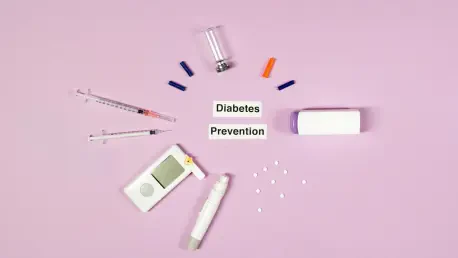Predicting type 1 diabetes with greater accuracy is a critical goal for researchers aiming to improve preventive healthcare. Early detection can significantly impact the management and treatment of this chronic disease, which often presents without warning. Recent innovations have led to a multivariable model that holds promise for transforming how medical professionals predict individual risk. The strategy involves using a composite of genetic, immunological, and demographic factors that provide a holistic view of an individual’s susceptibility to the disease. As researchers deepen their understanding of these factors, they are developing tools to integrate them into clinical practice effectively.
Understanding the Multivariable Model
Genetic and Environmental Factors
The multivariable prediction model incorporates genetic and environmental factors to enhance risk assessment for type 1 diabetes. Each element contributes uniquely to the overall understanding of an individual’s likelihood of developing the disease. Genetic predisposition, characterized by variations in specific genes, has been established as a strong risk factor. Research has broadened the scope, now incorporating comprehensive genetic risk scores that evaluate multiple loci associated with type 1 diabetes susceptibility. These scores provide a more nuanced understanding of genetic predisposition beyond single-gene analysis.
Environmental influences, particularly those encountered in early life, are also integrated into the model. Factors such as viral infections, dietary patterns, and geographical location can have significant impacts on the autoimmune processes that lead to type 1 diabetes. By combining genetic data with environmental history, the multivariable model offers a more comprehensive risk assessment. This dual approach empowers healthcare providers to identify at-risk individuals more accurately, paving the way for earlier interventions and tailored prevention strategies that could forestall the onset of clinical symptoms.
Role of Islet Autoantibodies
Islet autoantibodies serve as critical biomarkers in the prediction of type 1 diabetes, providing insights into the pre-clinical phase of the disease. These autoantibodies, which target pancreatic beta cells, can be detected long before the clinical symptoms manifest. Their presence is a strong indicator of the autoimmune response that characterizes type 1 diabetes. The multivariable model leverages the detection of these autoantibodies to refine risk assessment further.
Understanding the temporal progression and concentration of islet autoantibodies offers an invaluable tool for predicting disease onset. The model incorporates multiple islet autoantibodies, assessing both quantity and presence over time, to provide a more detailed picture of autoimmune activity. This ability to monitor dynamic changes enhances the predictive accuracy of the model. It aligns with the goal of providing healthcare professionals with the necessary tools to anticipate disease progression and implement timely interventions, reducing the risk of serious complications such as diabetic ketoacidosis.
Enhancements Through Validation and Recalibration
External Validation Processes
The robustness of any predictive model lies in its capacity to deliver consistent results across varying settings and populations. The multivariable model for type 1 diabetes underwent thorough external validation using data from diverse cohorts. This validation process is vital for ensuring that the model is reliable and applicable to multiple patient groups, thus enhancing its utility in real-world medical settings.
The TrialNet study, focusing on individuals with a family history of type 1 diabetes, served as a benchmark for validating the prediction model. Such external validation confirmed that the model could predict type 1 diabetes risk with high precision in various populations beyond the original cohort. Ensuring this generalizability was key to its eventual application in broader clinical contexts, guiding practitioners in making informed decisions tailored to individual patients, irrespective of demographic or genetic variations.
Improving Accuracy with Recalibration
Recalibrating the prediction model is a crucial step in enhancing its accuracy and applicability among different populations. Recalibration involves fine-tuning the model to account for cohort-specific variations in baseline risk and selection criteria. By adjusting for these differences, the model achieves improved alignment with real-world data and patient experiences, ensuring its predictions are both precise and relevant to individual cases.
This adjustment process has proven critical, particularly when adapting models to populations with distinct genetic backgrounds or socio-environmental exposures. Through recalibration, the model can maintain its predictive power by reflecting the actual risk profiles of diverse study participants. The recalibration efforts not only increase the predictive accuracy but also underscore the need for a flexible approach to applying scientific models in clinical practice. Consequently, practitioners can rely on more actionable insights when assessing and managing type 1 diabetes risk.
Practical Applications and Future Directions
Development of a Risk Calculator
Turning theoretical models into practical tools is essential for broader implementation in healthcare settings. As part of translating research findings into actionable insights, a user-friendly web-based risk calculator has been developed. This application aims to streamline the process of evaluating type 1 diabetes risk, making it accessible to both healthcare providers and patients.
The web application allows users to input relevant data such as genetic markers, presence of autoantibodies, and environmental factors, subsequently generating a personalized risk assessment. This pragmatic tool supports clinical decision-making by providing a visual representation of an individual’s risk profile, facilitating conversations about preventive measures or early detection protocols. As it becomes more widely adopted, this technology represents a significant leap toward enhancing patient care by leveraging the accuracy and comprehensiveness of the multivariable model.
Future Implications and Research Opportunities
Predicting type 1 diabetes with greater precision is crucial for researchers who are striving to advance preventive healthcare efforts. The early identification of this condition can play a significant role in controlling and treating what is often a silent disease until it manifests. Recently, significant strides have been made with the development of a multivariable model, offering transformative potential for predicting an individual’s risk. This model utilizes a blend of genetic profiles, immunological markers, and demographic details to create a comprehensive perspective on a person’s vulnerability to type 1 diabetes.
Researchers are delving deeper into these contributing factors, which has paved the way for the creation of sophisticated tools designed for integration into clinical environments. By incorporating these innovative strategies, medical professionals can achieve a more nuanced and comprehensive approach to prediction and prevention. Ultimately, the goal is not only to foresee the onset of type 1 diabetes more effectively but also to tailor preventive and management strategies that are personalized and responsive to each patient’s unique risk profile. This approach could significantly improve patient outcomes by offering insights that lead to early interventions, thereby reducing the long-term impact of the disease.









